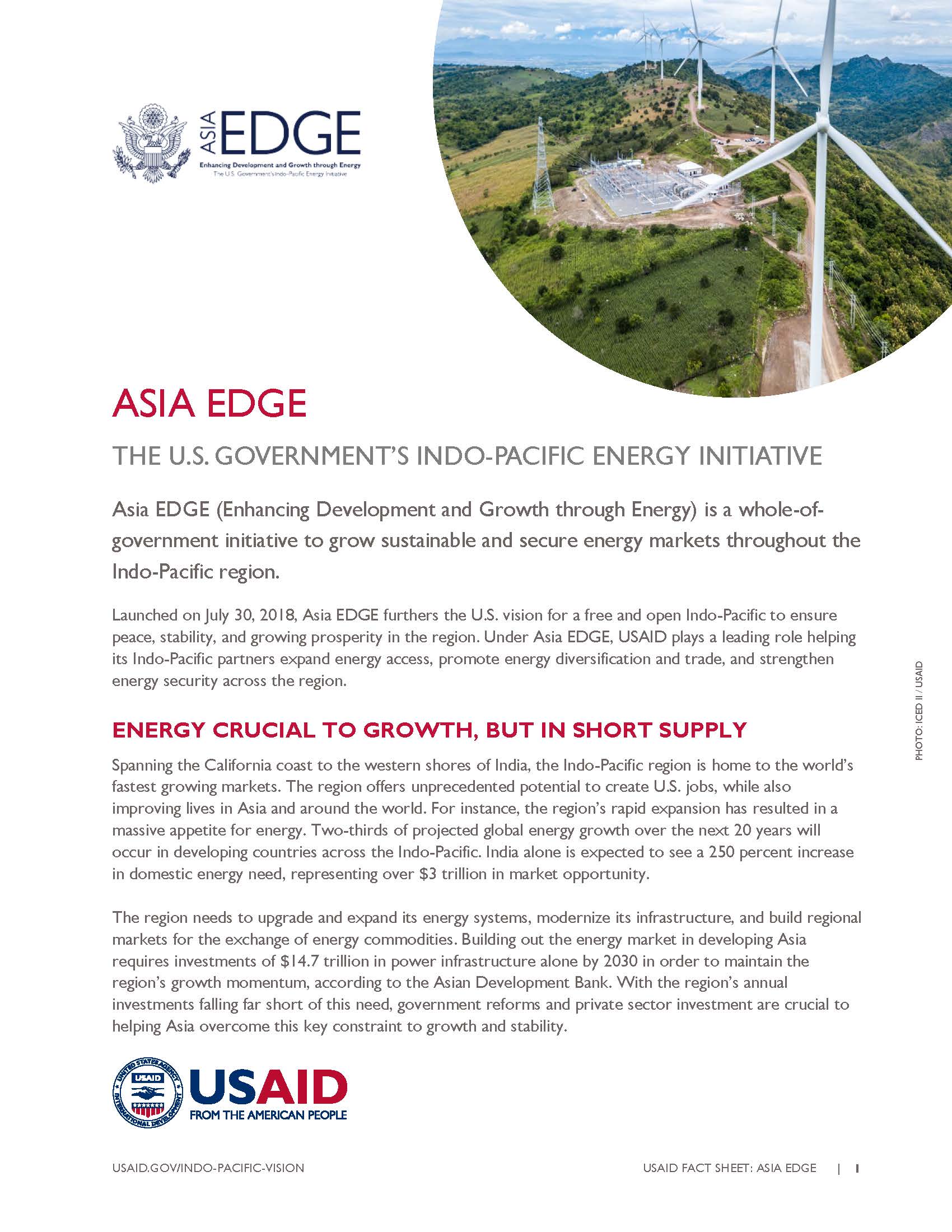- Where We Work
- Africa
- Asia
- Europe and Eurasia
- Latin America and the Caribbean
- Middle East
- Mission Directory
Speeches Shim
![]() (373k) Asia EDGE Fact Sheet
(373k) Asia EDGE Fact Sheet
THE U.S. GOVERNMENT’S INDO-PACIFIC ENERGY INITIATIVE
Asia EDGE (Enhancing Development and Growth through Energy) is a whole-of-government initiative to grow sustainable and secure energy markets throughout the Indo-Pacific region.
Launched on July 30, 2018, Asia EDGE furthers the U.S. vision for a free and open Indo-Pacific to ensure peace, stability, and growing prosperity in the region. Under Asia EDGE, USAID plays a leading role helping its Indo-Pacific partners expand energy access, promote energy diversification and trade, and strengthen energy security across the region.
ENERGY CRUCIAL TO GROWTH, BUT IN SHORT SUPPLY
Spanning the California coast to the western shores of India, the Indo-Pacific region is home to the world’s fastest growing markets. The region offers unprecedented potential to create U.S. jobs, while also improving lives in Asia and around the world. For instance, the region’s rapid expansion has resulted in a massive appetite for energy. Two-thirds of projected global energy growth over the next 20 years will occur in developing countries across the Indo-Pacific. India alone is expected to see a 250 percent increase in domestic energy need, representing over $3 trillion in market opportunity.
The region needs to upgrade and expand its energy systems, modernize its infrastructure, and build regional markets for the exchange of energy commodities. Building out the energy market in developing Asia requires investments of $14.7 trillion in power infrastructure alone by 2030 in order to maintain the region’s growth momentum, according to the Asian Development Bank. With the region’s annual investments falling far short of this need, government reforms and private sector investment are crucial to helping Asia overcome this key constraint to growth and stability.
UNLEASHING THE INDO-PACIFIC’S ENERGY POTENTIAL
USAID is leveraging its technical expertise, enduring regional presence, and convening power to help the Indo-Pacific region overcome its energy constraints. Our efforts promote utility modernization through digitization and performance enhancement, foster regional energy connectivity, attract increased levels of private sector investment, and accelerate the adoption of regional and bilateral competitive energy markets.
USAID support developing a competitive regional power market in South Asia has led to transformative policy changes that are increasing power trade in the region. For example, in December 2018, India revised its guidelines on cross-border power trade, enabling other countries to use India’s transmission lines as a pass-through for their electricity exchanges. This includes Nepal and Bangladesh, which in June 2019 struck an agreement to trade power using Indian power lines. In Indonesia, USAID’s assistance in integrating variable renewable energy into Indonesian power grids is unlocking new market opportunities, including for U.S. companies. This work has paved the way for the development of Indonesia’s first two utility-scale wind farms—by Colorado-based UPC Renewables, and Vena Energy, a subsidiary of the New York-based equity fund, Global Infrastructure Partners.
USAID’s Asia EDGE support focuses on four primary areas:
UTILITY MODERNIZATION: The region’s electric and gas utilities must be financially viable in order to provide—and expand—access to affordable, reliable energy. Historically, power utilities in Asia have been state-owned and often heavily dependent on government subsidies, functioning with obsolete technologies and poor maintenance practices. USAID helps advance the financial viability and efficiency of local power utilities through the modernization and expansion of transmission and distribution systems. USAID is also fostering the adoption of cybersecurity measures and sector and regulatory reforms, such as tariff restructuring.
INCREASED DEPLOYMENT OF ENERGY TECHNOLOGIES: A secure energy future requires meeting growing demand with best-value, competitively-priced solutions, while maintaining reliability and minimizing environmental impact. USAID support to the electricity and gas sectors prioritizes least-cost, long-term planning and efficient integration of transformative technologies, including battery storage, smart grids, electric vehicles, modern gas systems, and energy efficient products and practices.
TRANSPARENT, BEST VALUE PROCUREMENT: Open, transparent, and best-value procurement processes create a level playing field for U.S. and other companies, while allowing countries to affordably generate energy supplies. Corruption is often found in the Indo-Pacific’s energy sector procurements due to the absence of open, competitive bidding, especially for foreign suppliers. USAID promotes transparent, competitive energy procurement practices, including auctions, quality standards, and the legal and regulatory frameworks that enable a wide range of private sector participation in the energy sector.
REGIONAL ENERGY TRADE AND INTEGRATION: Regional electricity and gas market integration offers substantial economic benefits, and can unlock billions of dollars in the regional energy market. USAID helps develop legal and regulatory frameworks that enable power and gas trade and the development of power markets, including regional power exchanges. This effort will build on and leverage bilateral initiatives, including electricity market expansion, that strengthen and prepare individual countries for regional coordination and integration. It will also focus on expanding the downstream regional market for natural gas and LNG imports.


Comment
Make a general inquiry or suggest an improvement.